(Eng / Esp) Leche de Coco + Bonus
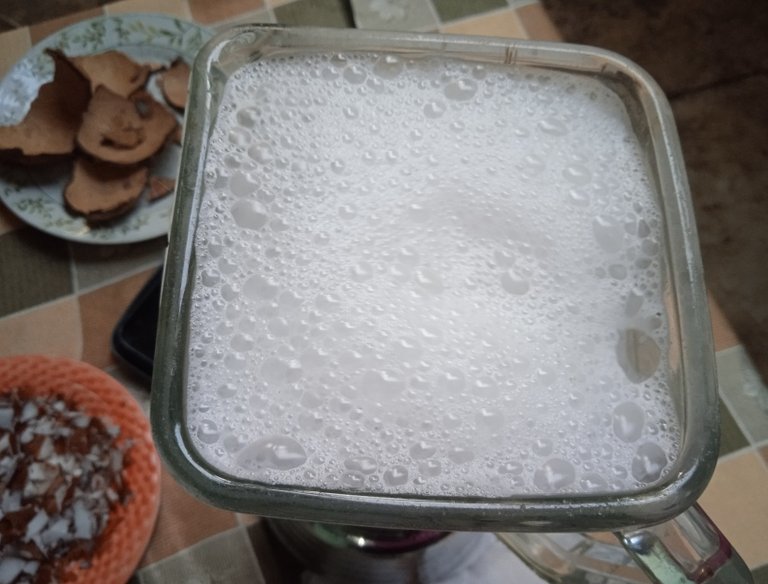
Saludos en este día a todos los amigos y lectores de mi hermosa comunidad Plant Power (Vegan). Hoy vuelvo con otra sencilla receta, que quizás muchos de ustedes la conocen ampliamente, pero quizás otros no, y se trata de una leche vegetal, en este caso LECHE DE COCO.

And here you can see the oat milk recipe
La leche de coco es un básico de la cocina vegana, pues es un ingrediente ideal para hacer recetas dulces y saladas. Es una leche cremosa, untuosa, nutritiva y de un delicioso sabor. Como mencioné en mi post anterior, vivo en zona rural, ganadera y muy calurosa, me es complicado el acceso a ciertos productos, como son frutas, verduras, y más aún a productos veganos ya procesados; así que he aprendido de manera autodidacta, a preparar varios elementos que requiero para cocinar, y uno de estos es la leche de coco. No mentiré, no la preparo con la regularidad que quisiera porque aquí tampoco se consiguen cocos, (vivo muy lejos de las zonas costeras de mi país, en donde esta fruta abunda); pero recientemente encontramos un vendedor que trae cada tres días cocos a la venta, y a un precio razonable (tres unidades por 1.2 dólares), así que ahora la consumiré con más frecuencia. Hoy traje la receta de su elaboración y qué hacer con la fibra sobrante del proceso (el bonus, jajajaja).

THE RECIPE / LA RECETA
Preparation time: I consider that this recipe can be made in 25 minutes (the milk). The drying of the coconut fiber requires a baking time of two hours at a very low temperature (I don't have a dehydrator).
Servings: From this amount of ingredients I obtained 800 ml of coconut milk, delicious, fresh and natural, plus 60 grams of dry coconut meat (it is really the remaining fiber).
600 ml of hot water.
2 brown coconuts. These ones that I used, one was younger than the other (its color was lighter) and therefore it would give more milk. The youngest coconut was the largest and weighed 500 grams, and the other 465 grams.
Bowls, pots, spoon knife, grater, blender, strainer, sterile jars for bottling, baking tray and absorbent paper or napkins, etc.
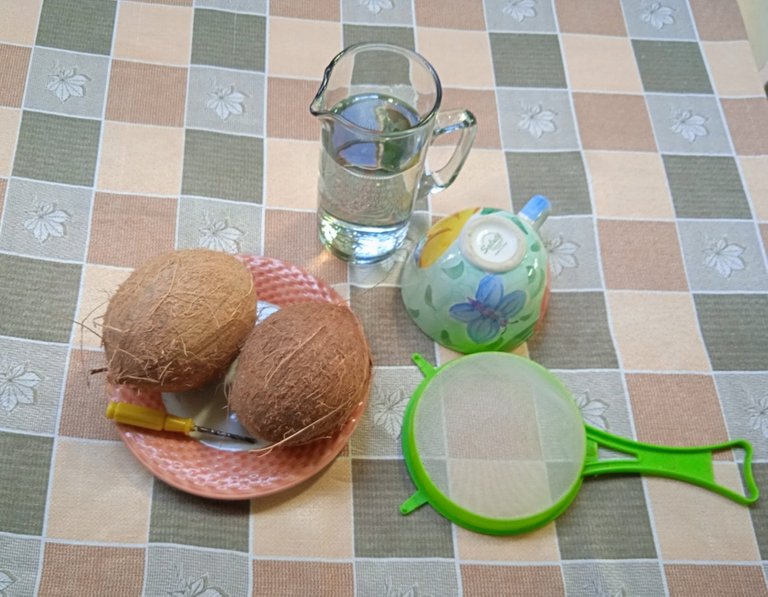
- Tiempo de preparación: Considero que en 25 minutos puede elaborarse esta receta, (la leche). El secado de la fibra de coco requiere un tiempo de horneado de dos horas a temperatura muy baja (no tengo deshidratador).
- Raciones: De esta cantidad de ingredientes obtuve 800 ml de leche de coco, deliciosa, fresca y natural, más 60 gramos de pulpa seca de coco (realmente es la fibra restante).
- 600 ml de agua caliente.
- 2 cocos marrones. Estos que utilicé uno era más joven que otro (su color era más claro) y por tanto daría más leche. El coco más joven era el más grande y pesaba 500 gramos, y el otro 465 gramos.
- Boles, ollas, cuchillo cucharilla, rallador, licuadora, colador, frascos estériles para embotellar, bandeja de hornear y papel absorbo o servilletas, etc.

Comenzamos abriendo un orificio en cada coco. Esta fruta por lo general trae tres “ojitos” en uno de sus extremos. Uno de estos “ojitos” es fácil de perforar, y así extraer el delicioso líquido (agua) que guarda dentro. Los otros dos “ojitos” son muy duros de abrir, así que se ubica ese que es suave. Yo utilicé aquí una antigua herramienta que compré hace mucho tiempo para recargar cartuchos de tinta y jamás utilicé, una especie de destornillador con una mecha espiralada. Procedo a extraer el contenido de cada coco, obteniendo en total un aproximado de 200 ml de agua, que se puede usar en la preparación de la leche. Yo aquí no la utilicé, sino que la enfrié y la bebí muy fría luego, ¡deliciosa!
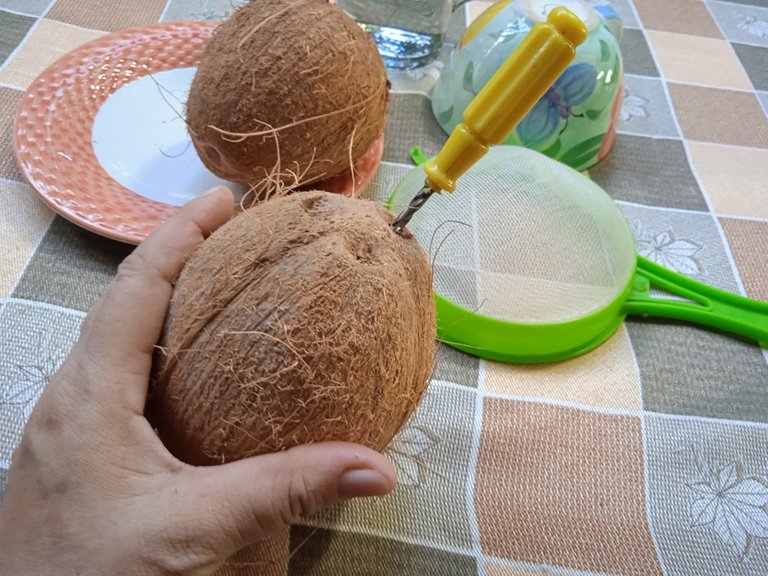



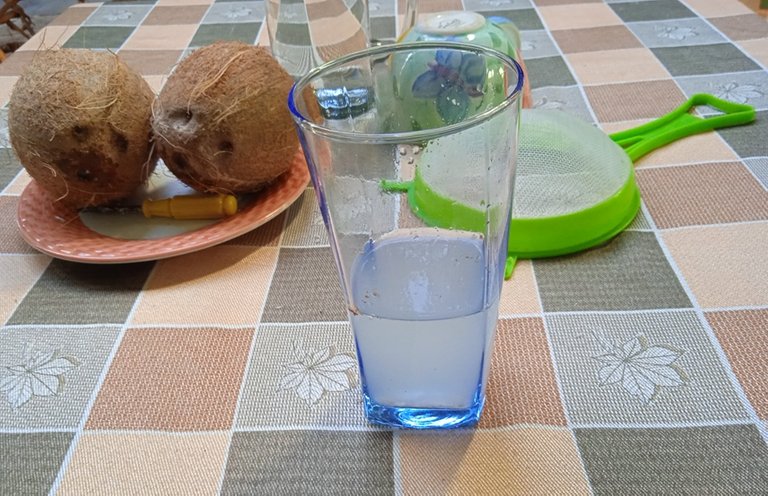

Ya vaciados los cocos, hay que partirlos. Utilicé una piedra de moler, envolviendo previamente cada coco en una bolsa plástica, esto evita que se desperdiguen los trozos al momento de partir la fruta. Posteriormente coloco el coco, directamente en fuego, en este caso en la hornilla de la cocina. Esto facilita que se desprenda la carne de su interior, que posteriormente emplearé en la receta. Es preciso ir rotando los pedazos de coco, para que reciban el calor de la llama de manera uniforme.
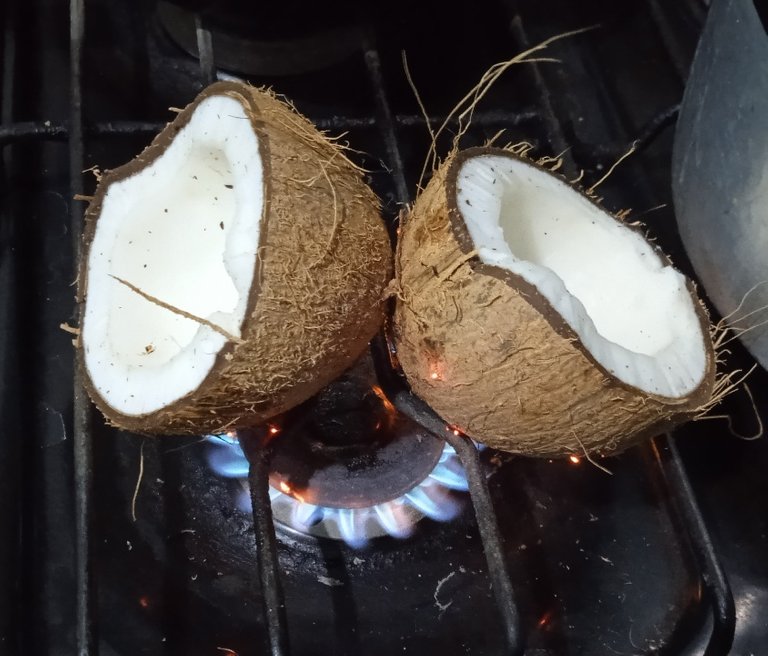

Una vez de haber retirado el coco del fuego, se desprende su contenido empleando un cuchillo fuerte de punta fina. Si ha recibido suficiente calor, saldrá fácilmente. Luego proceder a retirar la piel marrón que tiene, a fin de dejar la carne de coco limpia y blanca. Esta piel se la dí de comer al Sr. Morrocoy y su tribu, y la cáscara dura, sirvió de abono en el solar. De uno de los cocos, pude conservar un poco más intacta su cáscara, creo que las utilizaré para sembrar unas plantitas.
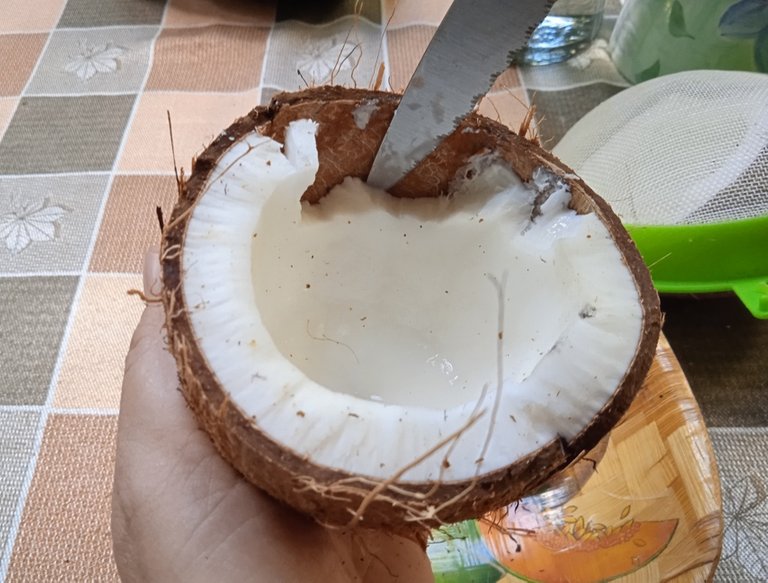
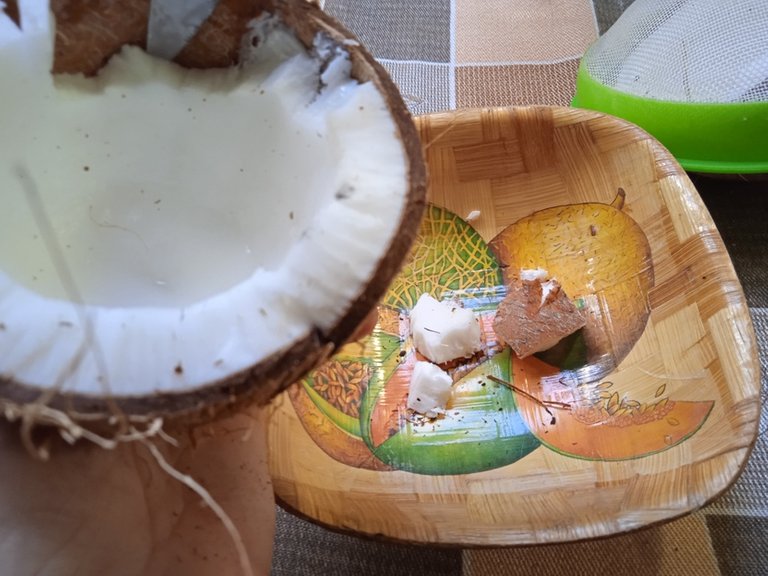
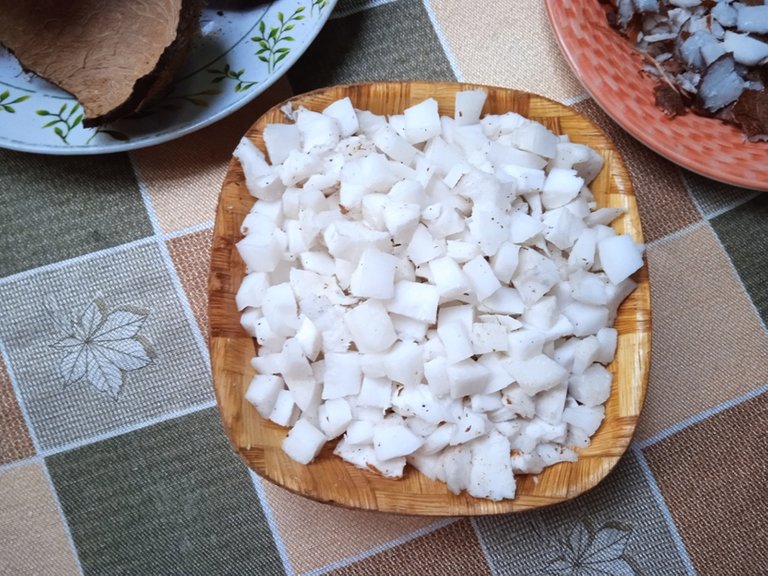
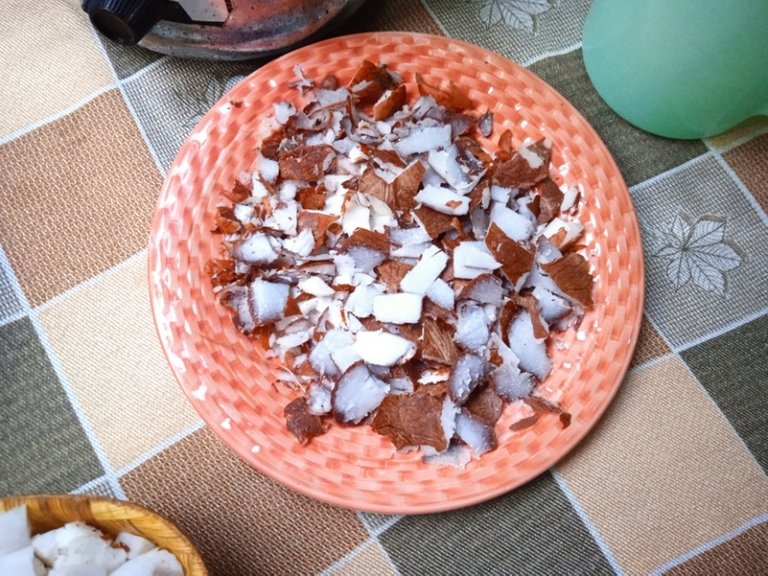
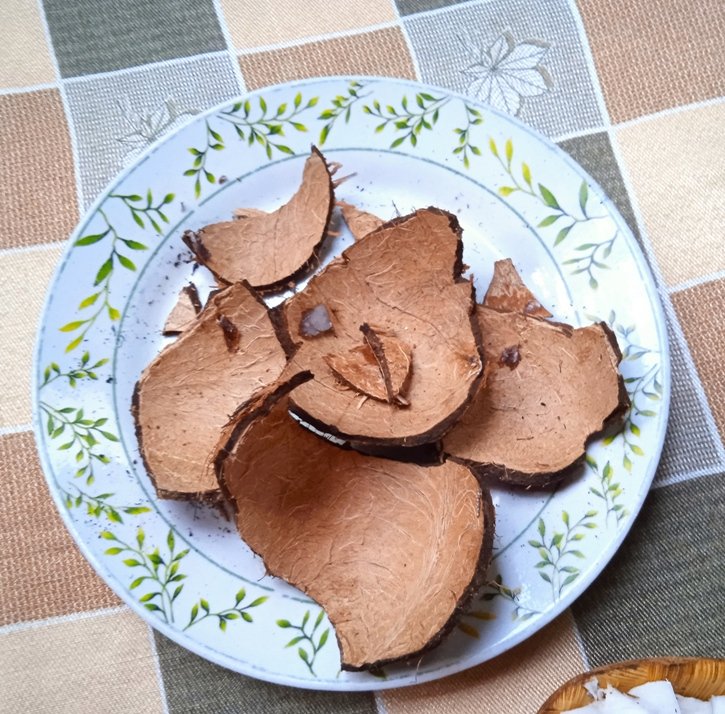
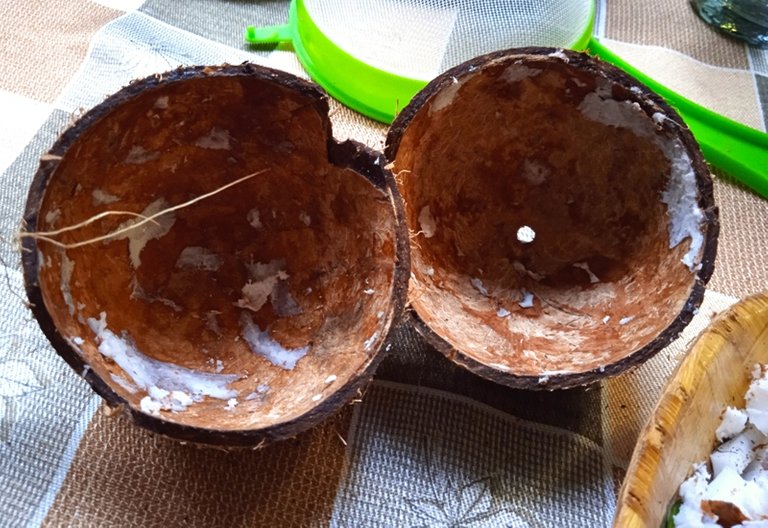

La carne del coco la corto menudamente, (también puede rallarse), a fin de facilitarle el trabajo a la licuadora. Procedo a licuarla de forma progresiva con el agua caliente, para luego colarla bien. Puede utilizarse un colador de malla fina, (como hice yo), o una tela fina. El contenido resultante es la leche de coco. Yo aquí obtuve 800 ml, pero si la quieres menos líquida, más espesa, puedes disminuir la cantidad de agua.
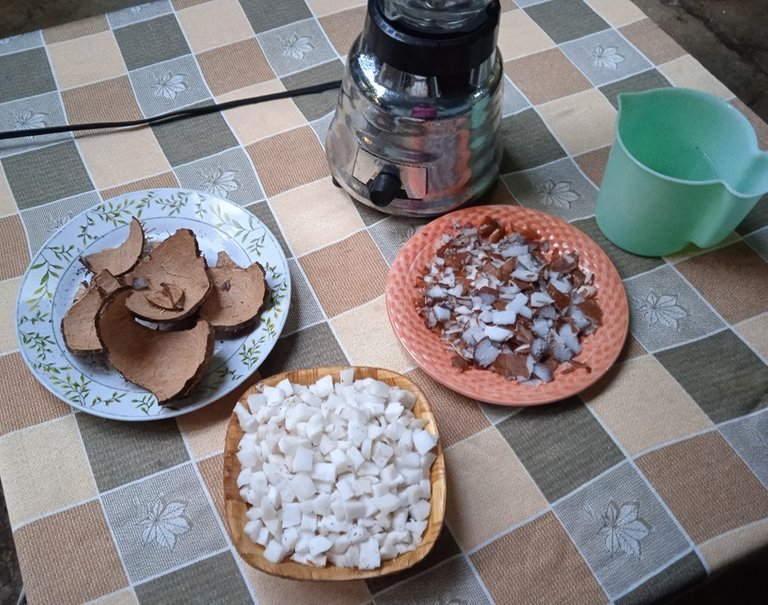
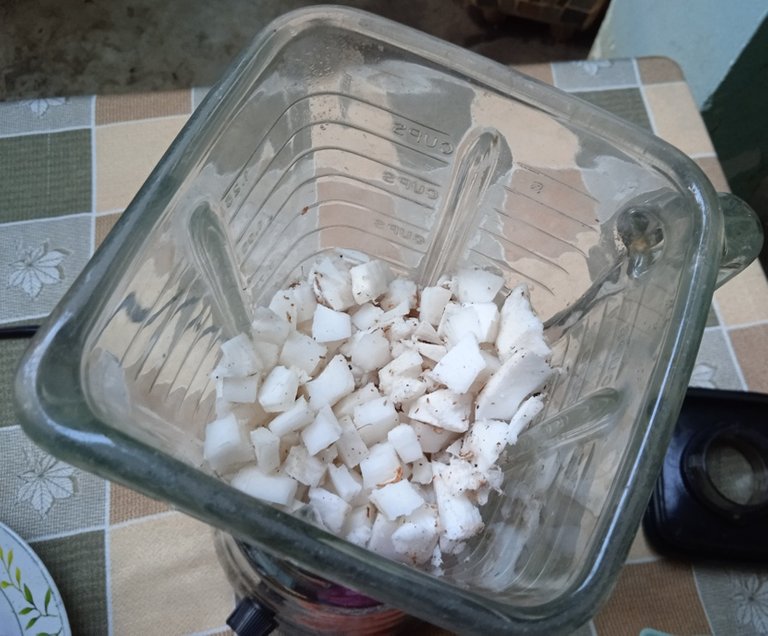
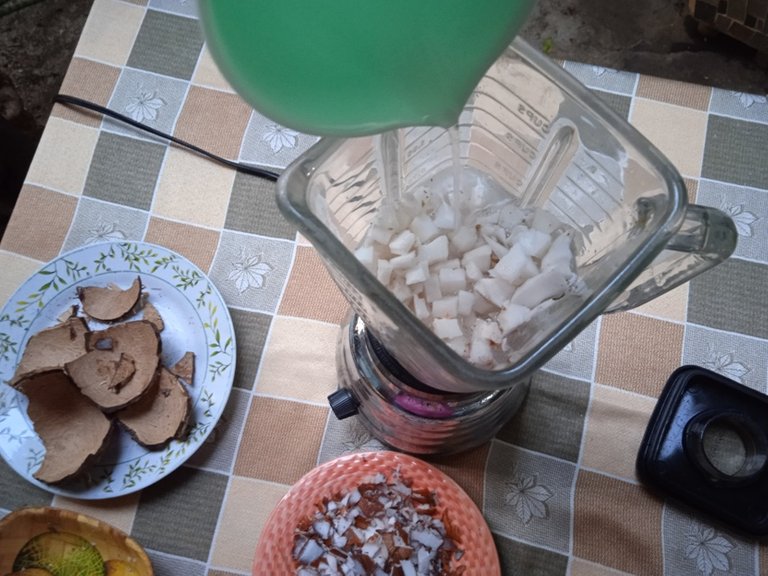
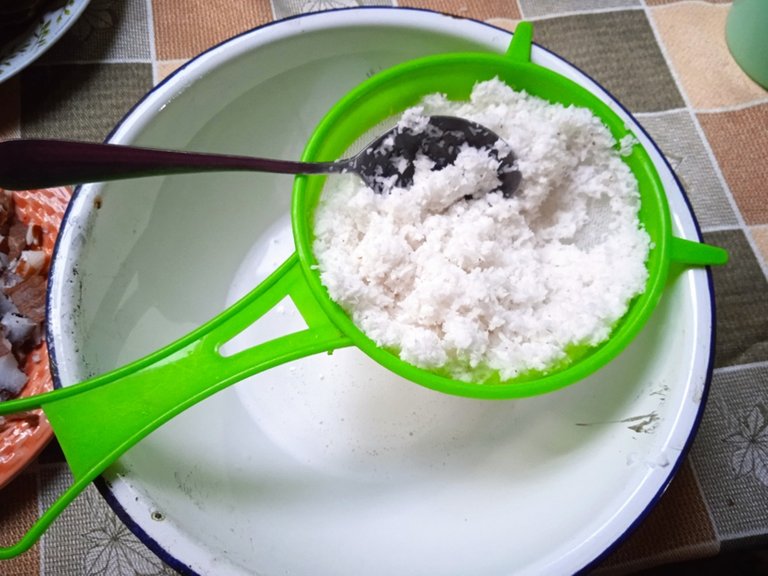
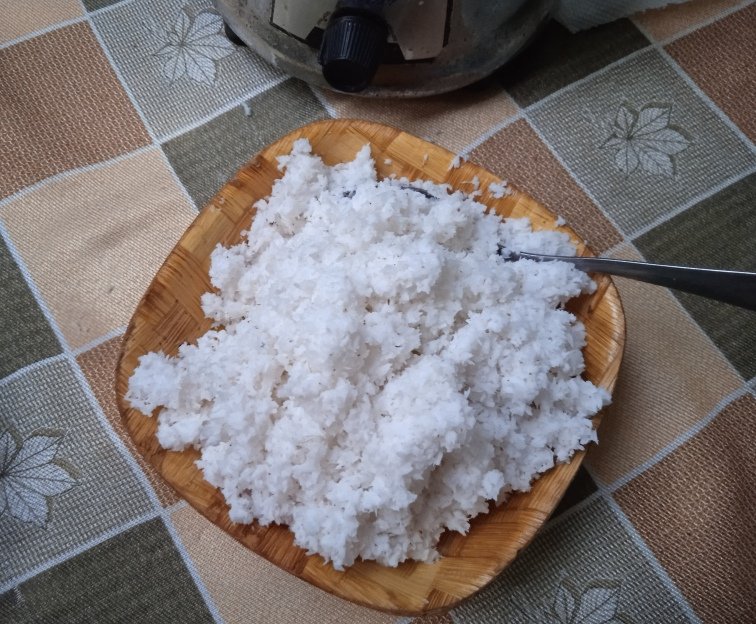
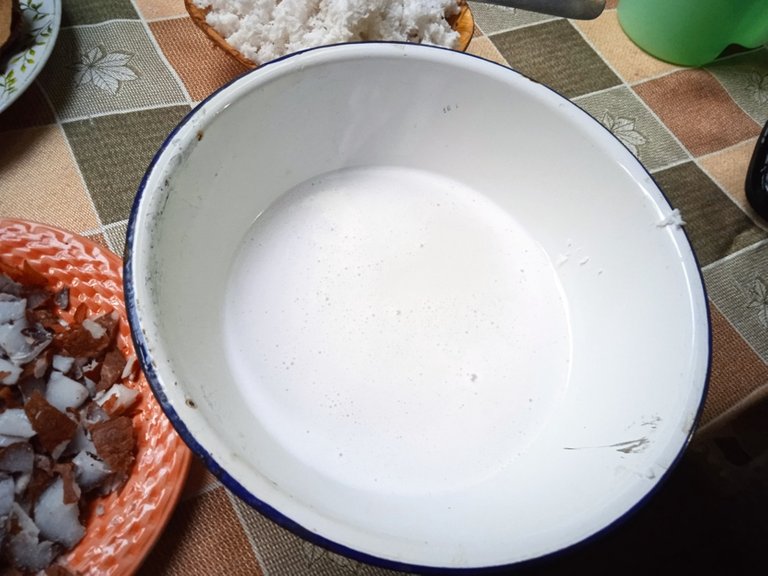

En el colador queda un residuo, que es la fibra del coco, que bien puede usarse como parte de compost, pero también puede aprovecharse al máximo en otras recetas, para darle volumen y estructura. Para ello, colocar este residuo en una bandeja de horneado, cubierta de papel absorbo o servilletas y hornear a temperatura muy baja, removiendo ocasionalmente en la bandeja, hasta que seque totalmente, para luego estar fría, guardarla en un frasco hermético. En mi horno fue necesario un lapso de dos horas. De un peso inicial de 465 gramos, al final del proceso quedó un total de 60 gramos de una fina fibra, totalmente. Esta fibra conserva en parte el olor a coco, pero no el sabor. Puede utilizarse para elaborar galletas y pasteles, tal como les diré en otro post.
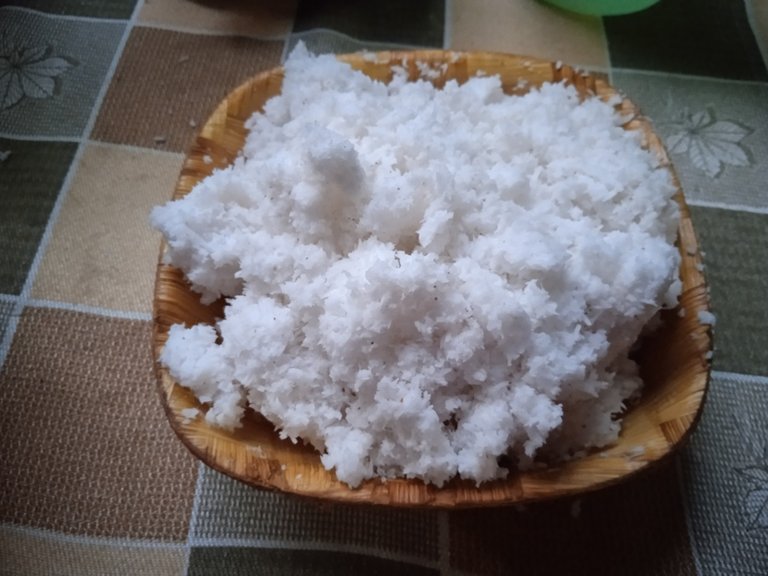
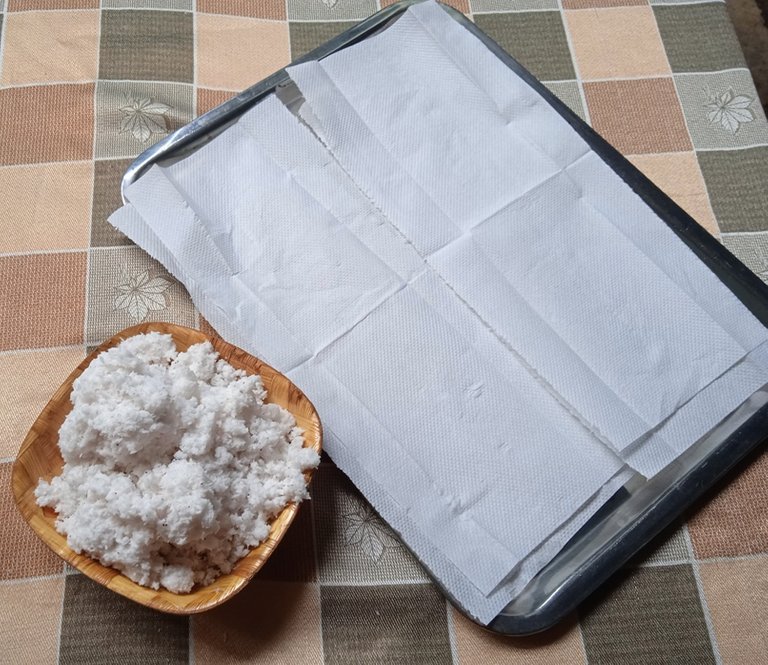

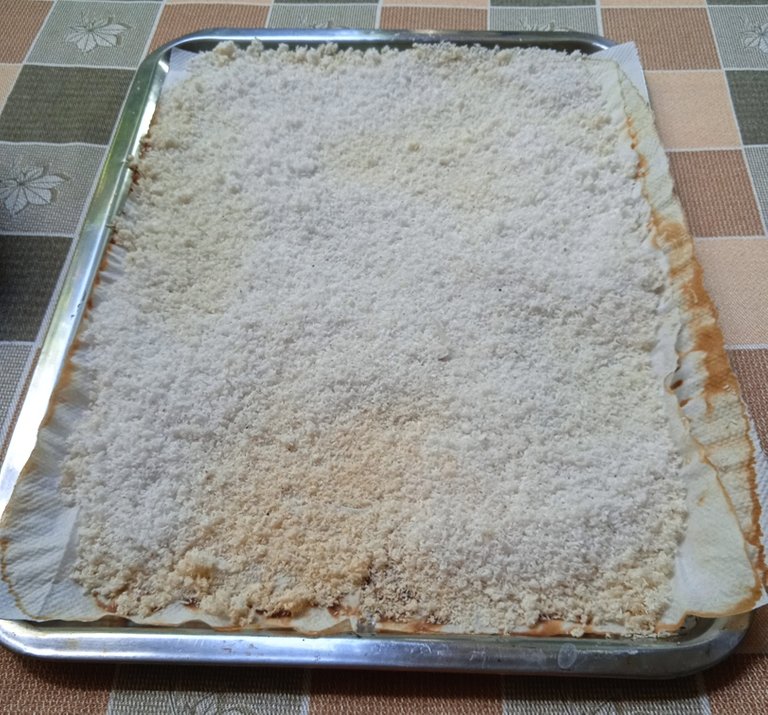
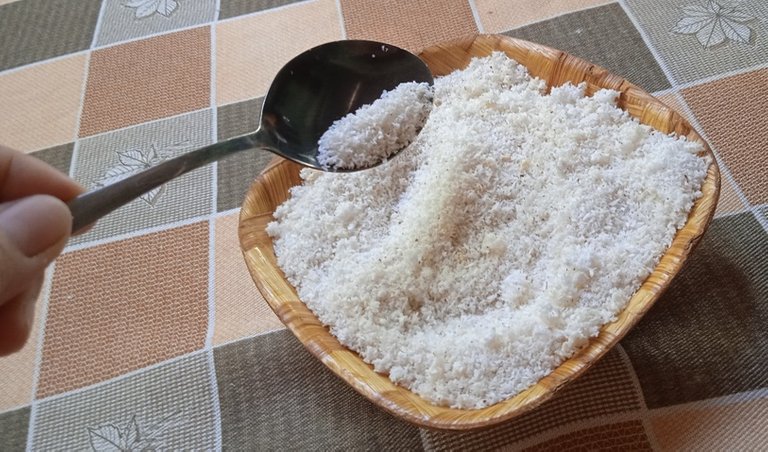

Aquí termino mi post de hoy, el cual trae una sencilla receta, pero muy necesaria. Espero que se animen a seguir haciendo recetas veganas, que son deliciosas, nutritivas y compasivas con la Madre Tierra.

These photos are my own, and were taken with a Xiomi REDMI 8 A phone
The dividers used are courtesy of @eve66 who shares beautiful designs that embellish the layout of our post.
In case it is required to use the content or images of this post and of my other publications, I would appreciate if you could refer to my authorship (Fabiola Martínez) and cite the corresponding link. Thanks.

 Delegations welcome!
Delegations welcome!Find our community here IICuration Trail


Hola @sirenahippie no lo vas a creer jajaja pero justo en este momento prepare un poco para hacer unas recetas 👨🏻🍳 , veo que la preparas un poquito similar a la mía 😁 pero ya te contaré mi forma de hacerla jajaja, mientras seguiré por la cocina limpiando un poco , continuar con las preparaciones 😊
Hola @edwing357, ¡qué bien! Sabes que hay distintas recetas para su elaboración, y todas son válidas, de seguro tu receta es genial. Luego me cuentas. Saludos.
Sip 😁 yo la vario según la preparación que vaya a elaborar 👨🏻🍳
Hola así la preparo yo cuando estoy estoy sola. Pero cuando está mi esposo lo ralla y extraigo la leche con una tela de algodón y la exprimo. Saludos
Así queda súper bien, me parece que queda más concentrada, más pura. Gracias por la visita y el comentario @theresa16
Hola mi amiga, encantada con esta receta, me diste algunos tips que no conocía, así que intentare hacerla muy pronto, gracias por compartir esta receta, saludos.🤗
Gracias a tí por tu visita y comentario @marivic10, me alegro sea de utilidad. Saludos.
¡Felicidades! Esta publicación obtuvo upvote y fue compartido por @la-colmena, un proyecto de Curación Manual para la comunidad hispana de Hive que cuenta con el respaldo de @curie.
Si te gusta el trabajo que hacemos, te invitamos a darle tu voto a este comentario y a votar como testigo por Curie.
Si quieres saber más sobre nuestro proyecto, acompáñanos en Discord: La Colmena.
¡Gracias por el apoyo!
Hola @sirenahippie, del coco se aprovecha todo jejeje, qué rica es el agua bien fría. Yo iba a preparar para mi torta, pero se había dañado el coco, ya estaba picado y tarde mucho en utilizarlo. Gracias por el tips para aprovechar la fibra restante.
Muchas gracias por tu visita @jessiencasa, sí el coco no tiene desperdicio, es una fruta bastante versátil. Lamento que se haya dañado el que tenías, sin embargo tu receta de pastel vegano quedó estupenda. Saludos.
Very interesting. I had absolutely no idea how to make this (truthfully, I wouldn’t even have dreamt of making this. Haha 😂). How innovative ❤️🤗💕🤗❤️
Hello, thank you for your visit. It is really simple. I didn't know the first time either, hahahahahaha, but it is a healthy, economical and viable alternative to obtain coconut milk. Greetings.
Bienvenidas las Delegaciones / Welcome Delegations
Trail de Curación / Curation Trail
Gracias por el apoyo.
Lo máximo que he hecho con el coco es helados, pero directamente con la carne del coco. De resto, cuando preparo galletas lo compro ya rallado, así que después de ver esta receta, no compraré más. Gracias por compartir! Muy interesante realmente para mí.
Gracias por la visita y el comentario @evelynchacin, sí, esta receta es una alternativa para hacer un uso completo del coco; sin embargo la fibra que se obtiene es algo insípida, es una fibra que contribuye a darle estructura a las preparaciones, más que sabor. Saludos.
Ah ok amiga, gracias por el dato. Saludos!
Your recipe is very healthy and nutritious food.Really so delicious coconut milk.You are perfect recipe maker.I hope it will be so delicious.I love this coconut milk food.Thanks for sharing friend
Thanks to you @simaroy for your visit and comment. I particularly like to prepare the basics of vegan cooking, since I don't have access to ready-made products, and I don't like them much either, so as much as possible, I resort to this type of recipe. Best regards.
Muy interesante 😊 muchos tendemos a preparar nuestra propia leche de coco genial está fruta tan exótica beneficiosa y la cual es un todo en uno destacada en postres, guisos, bebidas y pare de contar es bueno conocer diferentes versiones de sus preparaciones gracias por compartir 😊
Congratulations @sirenahippie! You have completed the following achievement on the Hive blockchain and have been rewarded with new badge(s):
Your next target is to reach 5750 replies.
You can view your badges on your board and compare yourself to others in the Ranking
If you no longer want to receive notifications, reply to this comment with the word
STOPCheck out the last post from @hivebuzz:
Support the HiveBuzz project. Vote for our proposal!
Hola Holaaaa. Excelente receta. Justo hice leche de coco un poco diferente y subiré la receta jeje. A Santi le retiraron la de vaca por unos días. Me gusta como secas la fibra del coco, la he usado húmeda para ponquecitos.
Hola @kyleana, feliz lunes, gracias por la visita. También puede usarse húmeda, si vamos a elaborar la receta de una vez. Espero que a Santi le guste la leche de coco. De seguro tu técnica también es genial. Saludos.
Jeje yo también 😊 😊 le hará bien a su pancita. Ahhhh si? La he usado seca. Entonces probaré de una vez.
Dear @sirenahippie,
May I ask you to review and support the Dev Marketing Proposal (https://peakd.com/me/proposals/232) we presented on Conference Day 1 at HiveFest?
The campaign aims to onboard new application developers to grow our ecosystem. If you missed the presentation, you can watch it on YouTube.
You cast your vote for the proposal on Peakd, Ecency, Hive.blog or using HiveSigner.
Thank you!
Is the last photo the final product? I wonder how it tastes like 😊
Hi @jane1289, what a nice visit!
Look, there are two end products here. The first is milk, this photo:
And the second is the dried coconut fiber, which is this photo:
Thank you for your visit. Today I may upload the post where I use both products. Greetings.
Woah.. I never knew that. Thanks for sharing this hack. 😊
We usually throw this after extracting the milk. The only thing I know it could used for is for a local candy we call "bukayo".
This is contains a number of very useful information. Thanks for sharing it.
!1UP
Hello, what a visit and such cool comments! I'm glad the tip is helpful.
Regarding the sweet bukayo, I think I will research and make a vegan version of it.
Thanks for the support, cheers!
You have received a 1UP from @thecuriousfool!
@ctp-curator
And they will bring !PIZZA 🍕.
Learn more about our delegation service to earn daily rewards. Join the Cartel on Discord.
Thanks for the suppport!
Nice